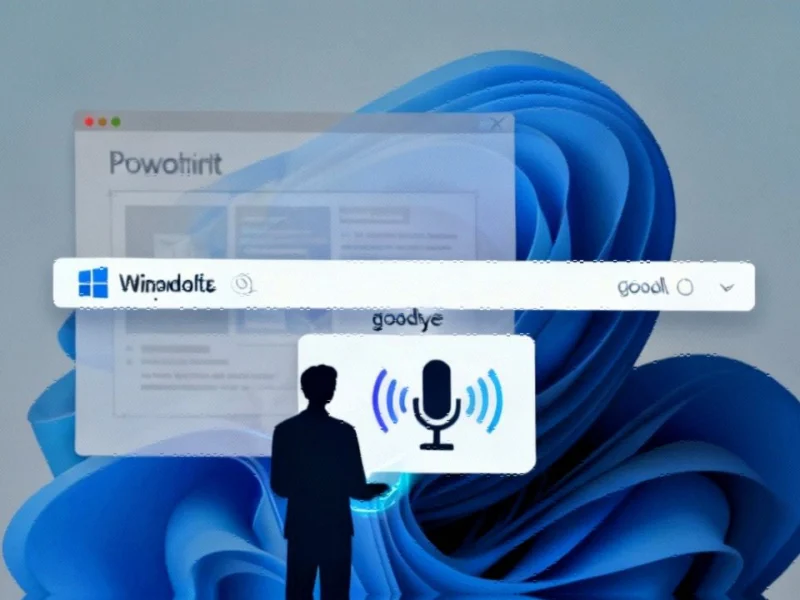Note: Featured image is for illustrative purposes only and does not represent any specific product, service, or entity mentioned in this article.
Windows 11’s Evolution Into an AI-First Platform
Microsoft has fundamentally reimagined the human-computer relationship with its latest Windows 11 update, positioning every compatible device as an AI-powered conversational partner. The introduction of wake-word activation and expanded Copilot capabilities represents a strategic shift toward ambient computing, where users interact with their devices through natural conversation rather than traditional input methods.
“We believe this shift to conversational input will be as transformative as the mouse and keyboard in terms of unlocking new capabilities on the PC for the broadest set of people,” said Microsoft executive vice president and consumer chief marketing officer Yusuf Mehdi. This vision aligns with broader industry developments toward more intuitive human-machine interfaces.
Hands-Free Computing: The New Copilot Experience
The updated Windows Copilot now responds to the “Hey Copilot” wake phrase, similar to how voice assistants operate on smartphones and smart speakers. Once activated, the system provides both visual and auditory feedback – displaying a microphone icon and emitting a sound to confirm it’s listening. The conversation continues until the user says “goodbye” or the feature times out, though traditional dismissal methods like clicking the close button remain available.
This voice-first approach represents Microsoft’s ambition to make computing more accessible while reducing physical interaction requirements. The technology builds upon related innovations in hands-free operation across various technology sectors.
Context-Aware Assistance Through Screen Sharing
Perhaps the most significant advancement is Copilot’s new ability to analyze active applications when shared by the user. This contextual understanding enables the AI to provide specific, relevant assistance based on what’s actually happening on screen. For example, when a user shares a PowerPoint presentation, Copilot can evaluate the content, suggest improvements, identify inconsistencies, or recommend design enhancements.
This application-aware functionality marks a substantial leap beyond simple voice commands, positioning Copilot as a genuine collaborative partner in productivity tasks. The capability reflects broader market trends toward context-aware computing systems.
Expanding Capabilities: Vision and Gaming Integration
Microsoft’s AI ambitions extend beyond voice commands. The company has announced upcoming text support for Copilot Vision, which previously operated exclusively through voice interactions. This expansion will initially debut for Windows Insiders – users who voluntarily test pre-release software – before rolling out to the general public.
Meanwhile, the gaming segment receives specialized attention with Gaming Copilot, now in Beta and available through the Xbox PC Game Bar for users 18 and older. Whether players need strategic advice during gameplay or recommendations for what to play next, the AI assistant aims to enhance the entire gaming experience. This gaming-focused AI implementation follows recent technology investments across multiple sectors.
Optional AI: Maintaining User Choice
Recognizing that not all users welcome AI integration, Microsoft has ensured that the Copilot features remain optional. Users skeptical of AI or simply uninterested in the functionality can disable or ignore these capabilities entirely. This approach acknowledges diverse user preferences while still pushing the platform forward.
The healthcare sector has seen similar considerations in its adoption of artificial intelligence, as evidenced by recent technology implementations that balance innovation with user comfort levels.
For those seeking more detailed analysis of Microsoft’s strategic direction, comprehensive coverage of the Windows 11 transformation provides additional context about how these changes fit into the company’s broader ecosystem strategy.
The Future of PC Interaction
Microsoft’s latest update represents more than just feature additions – it signals a fundamental rethinking of how users interact with their computers. By making voice a first-class input method and enabling AI to understand on-screen context, the company is laying groundwork for a future where computers serve as proactive partners rather than passive tools.
As these technologies mature and users become accustomed to conversational computing, we may indeed look back on this transition as the moment when the traditional mouse-and-keyboard paradigm began its gradual evolution into something more natural, intuitive, and powerfully collaborative.
This article aggregates information from publicly available sources. All trademarks and copyrights belong to their respective owners.



